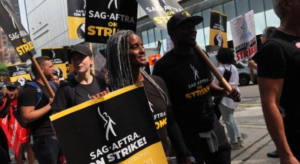By Edwin Freeman
Photos: Edwin Freeman
The Screen Actors Guild-American Federation of Television and Radio Artists (SAG-AFTRA) strike concluded at 12:01 a.m. PT on Thursday, November 9, 2023, though the tentative deal reached with studios still needs to be formally approved by the SAG-AFTRA national board when it meets on Friday, November 10. The four-month strike addressed issues like streaming residuals and diversity initiatives.

But many are asking, what does the end of this strike mean for African Americans in Hollywood?
Recent data shows Black actors and crew members continued to be underrepresented in the industry during the work stoppage. African Americans accounted for just 7.4% of lead roles in top films in 2020, according to the latest UCLA diversity report. That number rose slightly to 8.2% in 2021 films, but still lags far behind the 12.4% Black share of the U.S. population.
For crew members, only 5.5% of directors and 2.2% of unit production managers were African American in 2020, per the latest Hollywood Diversity Report.
With fewer lead roles and key behind-the-scenes jobs to begin with, the 4-month strike exacerbated financial hardships and curtailed career advancement for many Black creatives. The lack of work opportunities also impacted up-and-coming Black union members trying to gain a foothold during that time.

While the SAG-AFTRA strike may be over, lasting change is still needed to improve representation of Black artists in Hollywood. The industry must take concrete steps to increase hiring and casting of African American actors, directors, writers and other crew positions. Additionally, studios and production companies should prioritize developing, funding and distributing films and television shows that authentically showcase Black stories and voices.
The long-term success of African Americans in the entertainment business depends on access to quality jobs both in front of and behind the camera. As production starts up again, industry leaders must demonstrate a real commitment to inclusion. The time is now to take action to expand opportunities for the immense talents within the Black creative community. Only then can Hollywood move closer to reflecting the diversity of America itself on screen.


